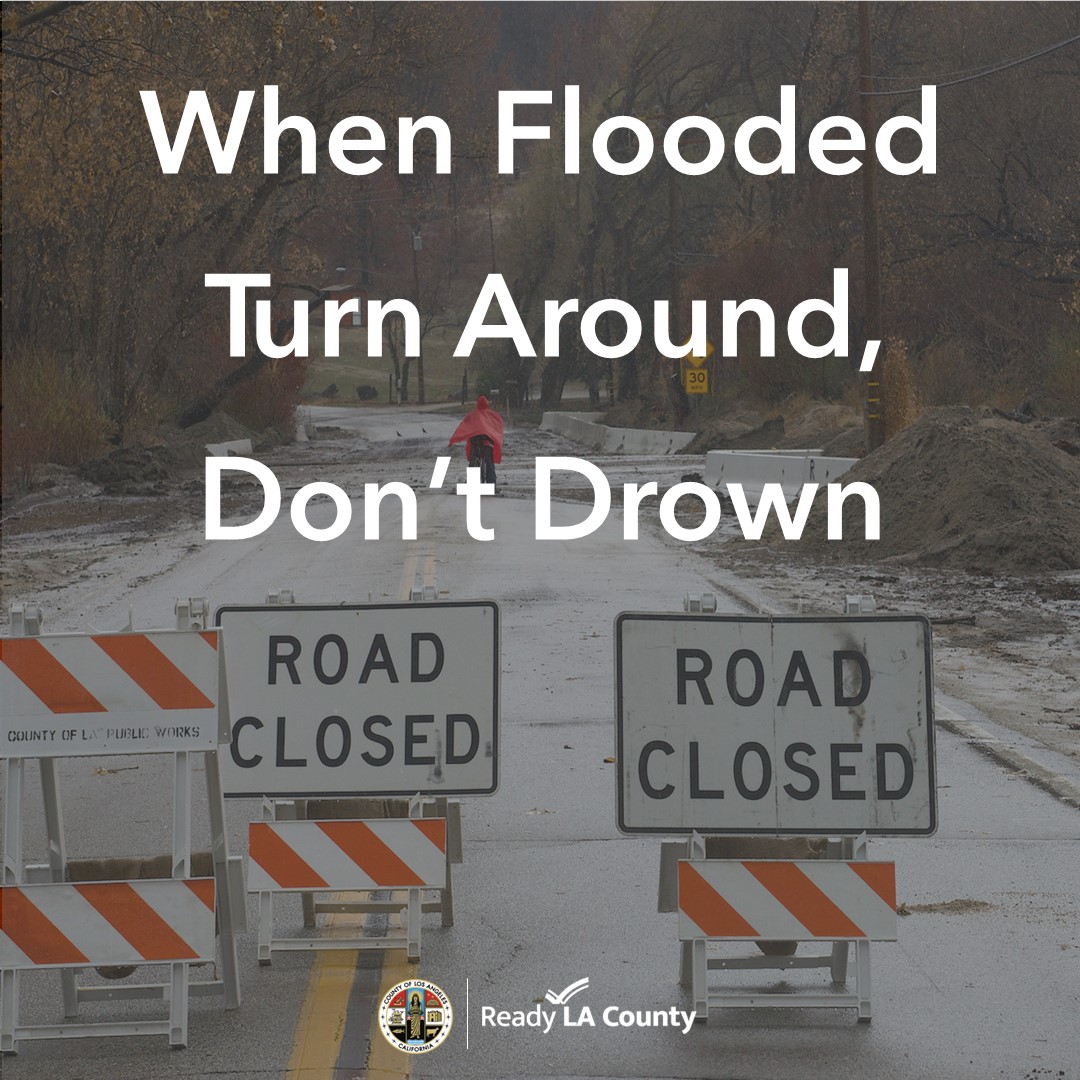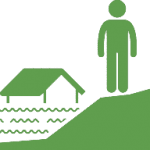Understanding Flood Hazards
Flooding is a temporary overflow of water onto land that is normally dry. Floods are one of the most common hazards in the United States, and in certain parts of Los Angeles County. They can cause deaths, injuries, significant property damage and can also contaminate drinking water and disrupt electrical service.
Not all floods are alike. Some floods develop slowly, sometimes over a period of days. Flash floods can develop quickly, sometimes in just a few minutes and without visible signs of rain. Flash floods often have a dangerous wall of roaring water that carries rocks, mud, and other debris and can sweep away most things in its path.
Be aware of flood hazards no matter where you live, but especially if you live in low lying areas, near water, or near a recently burned hillside. Take the following actions to help reduce your risk of death, injury and property losses from flooding.
Be Prepared for Flooding
You can reduce the potential impacts of flooding by doing the following before the rains and flooding begin:
- Know the type of flood risk in your area. Visit FEMA’s Flood Map Service Center or the California Governor’s Office of Emergency Services My Hazards website for information. You can also check with your local public works, building or planning department to see if you live in an area subject to flooding. The Los Angeles County Department of Public Works has flood information available via their website www.dpw.lacounty.gov.
- Register with your community’s local emergency mass notification system. Sign up to receive emergency notifications from Alert LA County or identify and sign up for the emergency notification system utilized by your city to stay informed about emergencies and disasters.
- Monitor the weather for forecasted heavy rainfall. The National Weather Service Los Angeles/Oxnard Weather center’s website is a great source of information. Local news broadcasts are also a good option to monitor.
- Develop a family emergency plan that includes home evacuation routes, locations of utility shut-offs, and how family members will contact or reconnect with you if separated. Make sure that there is also an out-of-state contact too.
- Make a disaster supply kit that includes enough food, water and medications that could last for at least 10 days. Keep it handy if case you have to relocate or evacuate immediately, or if your utility services are cut off. Don’t forget the needs of pets, and keep in minds each person’s specific needs when creating your supply kit.
- Teach children and teenagers not to play in or near rivers, riverbeds, streams or other areas of potential flooding.
- Store the following materials for protecting your home in a location away from potential flooding: sandbags, plywood, lumber and plastic sheeting.
- Keep important documents in waterproof containers or sealed bags. Create password-protected digital copies.
- Protect your property. Move valuables to higher levels. Clear debris and overgrowth from storm drains and gutters. Notify your local department of public works about debris and overgrowth in public drainage facilities.
Staying safe: During the Flood


Avoid Moving Water
Do not drive or walk through moving water. You can be knocked off your feet in as little as 6 inches of water. Avoid unnecessary trips.

Avoid Risky Areas
Stay away from streams, rivers, flood control channels and other areas subject to sudden flooding. Do not “sightsee” or enter restricted areas.

Stay Informed
Listen to the radio or watch television for information and instructions from your local officials. Pay attention to any notices coming from your local emergency notification system(s), and follow instructions.

Obey Evacuation Instructions
If you are told to evacuate, do so immediately. Never drive around barricades. Local responders use them to safely direct traffic out of flooded areas.

Drive Safely
If your vehicle is trapped in rapidly moving water, then stay inside. If water is rising inside the vehicle, then seek refuge on the roof.

Seek Higher Ground
Move to higher ground if you’re caught by rising waters. If you’re trapped in a building, then go to its highest level. Don’t climb into a closed attic; you may become trapped by rising floodwater. Go to the roof only if necessary; once there, signal for help.
Quick Tip: When There’s a Flood Warning or Watch
When there is a flood warning or watch issued for your community, relocate valuables from lower to upper floors and be prepared to move to a safe area when authorities advise. Disconnect all electrical appliances or turn off electric circuits at the fuse panel or circuit breaker panel before evacuating (if you have time to do so).
Staying safe: After the Flood
- Listen to authorities for information and instructions. Return home only when authorities say it is safe.
- Avoid driving, except in emergencies.
- If flood water entered your home:
- Don’t use fresh or canned foods that came in contact with flood waters.
- Snakes and other animals may be in your house. Wear heavy gloves and boots during clean up.
- Be aware of the risk of electrocution. Don’t touch electrical equipment if it is wet or if you are standing in water. If it is safe to do so, turn off the electricity to prevent electric shock.
- Avoid wading in floodwater, which can contain dangerous debris and be contaminated. Underground or downed power lines can also electrically charge the water.
- Follow the instructions of local officials regarding the safety of drinking water. Boil or purify water if you’re in doubt. Pump wells and test the water before drinking.
- Avoid going into disaster areas.
- Maintain a safe distance from downed power lines and broken gas lines; immediately report them to the appropriate utility.
- Use flashlights, rather than lanterns, candles or matches, to check on the condition of buildings. Flammables may be present.
Quick Tip: Flood Insurance
Damage and other flooding losses are not covered by most homeowner’s insurance policies. However, the Federal Emergency Management Agency (FEMA) offers special flood and insurance through its National Flood Insurance Program. Contact your insurance agent or visit FEMA.gov for more information.
Los Angeles County residents, renters, and business owners, including persons with disabilities and others with access and functional needs, may call 211 LA County for emergency preparedness information, and other referral services. The toll-free 2-1-1 number is available 24 hours a day and seven days a week. 211 LA County services can also be accessed by visiting https://211la.org


